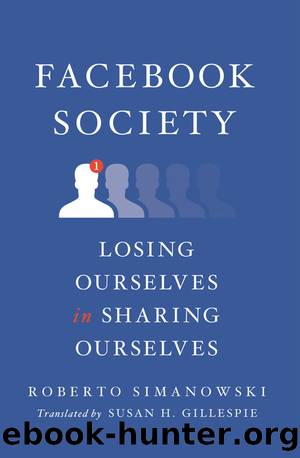Facebook Society by Roberto Simanowski

Author:Roberto Simanowski
Language: eng
Format: epub
Publisher: Columbia University Press
AFTERWORD
“Never before has an age been so informed about itself, if being informed means having an image of objects that resembles them in a photographic sense.” Kracauer immediately contradicts this praise of photography when, a few lines later, he characterizes it as a “strike against cognition,” because reproducing reality mechanically makes it superfluous to grasp it consciously. Kracauer’s commentary on photography provoked a discussion of the cognitive achievement of social networks and the informativeness of Facebook society. What we found was that the photographic form of self-representation delegates individual experiences to the social network and suppresses narrative forms of perception. This conclusion may seem less threatening in light of the critique levied against the narrative mode and given the corresponding advantages of forgetting. In the context of this critique, the episodic, phatic model of communication on Facebook was advanced as practicing a model of community that transcends divisive narratives and identity constructions. This unorthodox perspective, then, took yet another turn with the call for “weak thinking,” as habitual tolerance that results from “working through” conflict, as opposed to unreliable indifference, avoiding all conflicts, in the model of phatic communication. “Weak thinking” responds to discredited narratives not with opposing stories but as a “story” that is opposed to stories. It is the alternative, less popular reaction to the vacuum left by the loss of traditionally meaning-creating stories: an alternative to self-satisfied communication on Facebook, which enjoys the popularity it does because it is experienced as liberation from communication that is weighed down by meaning. This liberation is the site of the “go-for-broke” gamble of history, which Kracauer, ninety years ago, wrote about in relation to photography.
From his description of the increasing popularity of photography as a loss of society’s knowledge of itself, Kracauer derived a surprising prognosis. Photography, he said, makes society fall silent because in it the material itself, bypassing its meanings, speaks as a “barren self-presentation of spatial and temporal elements.” In doing so, photography, he claimed, frees consciousness from the narrative orders given to things by human beings and brings it into direct contact with nature. This liberation makes it possible to reframe meaning, in order to “awaken an inkling of the right order of the inventory of nature,” presuming that “a society that has succumbed to mute nature” does not persist. The risk, then, lies in muteness persisting after all, which, for Kracauer, would mean the “eradication” of consciousness: “The turn to photography is the go-for-broke gamble of history.”1
A medium as a game of chance? Is this metaphor anything more than slyly formulated cultural pessimism? Does it anticipate Walter Benjamin’s “positive concept of barbarism,” with which, five years later, the latter would greet the gambling away of the “human heritage” for the “small change of the ‘contemporary’ ” as “making a new start”?2 Is history, today, once again betting everything on a single card—with objective forms of self- and world representation that elevate the “foundation of nature devoid of meaning” characteristic of photographic documentation—going all in on
Download
This site does not store any files on its server. We only index and link to content provided by other sites. Please contact the content providers to delete copyright contents if any and email us, we'll remove relevant links or contents immediately.
Cecilia; Or, Memoirs of an Heiress — Volume 1 by Fanny Burney(31326)
Cecilia; Or, Memoirs of an Heiress — Volume 3 by Fanny Burney(30929)
Cecilia; Or, Memoirs of an Heiress — Volume 2 by Fanny Burney(30886)
The Great Music City by Andrea Baker(21196)
We're Going to Need More Wine by Gabrielle Union(18067)
Bombshells: Glamour Girls of a Lifetime by Sullivan Steve(13102)
Pimp by Iceberg Slim(12924)
All the Missing Girls by Megan Miranda(12741)
Fifty Shades Freed by E L James(12444)
Norse Mythology by Gaiman Neil(11876)
Talking to Strangers by Malcolm Gladwell(11865)
Crazy Rich Asians by Kevin Kwan(8343)
Mindhunter: Inside the FBI's Elite Serial Crime Unit by John E. Douglas & Mark Olshaker(7830)
The Lost Art of Listening by Michael P. Nichols(6465)
Enlightenment Now: The Case for Reason, Science, Humanism, and Progress by Steven Pinker(6404)
Bad Blood by John Carreyrou(5763)
The Four Agreements by Don Miguel Ruiz(5503)
Weapons of Math Destruction by Cathy O'Neil(5032)
We Need to Talk by Celeste Headlee(4863)
